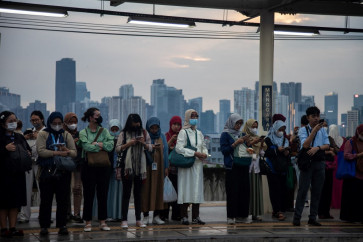Popular Reads
Top Results
Can't find what you're looking for?
View all search resultsPopular Reads
Top Results
Can't find what you're looking for?
View all search resultsRagunan zoo: Not so rosy
Just a few days before Idul Fitri, which fell on Sept
Change text size
Gift Premium Articles
to Anyone
Just a few days before Idul Fitri, which fell on Sept. 10 this year, the Ragunan zoo in Jakarta seemed like a haven of serenity.
Big ride: Residents queue to ride an elephant at Ragunan zoo, Jakarta. JP/R. Berto Wedhatama
Roars from the big cats and the clanging of the gates occasionally broke the silence. In fact, an elephant was determined to grab the attention of its mates in another gated area by banging its head against the gates.
Closer inspection, however, revealed a different picture.
Several other elephants, with chains dangling on their legs, were cramped in an enclosed area, while two bears sat staring blankly from their compound, an area hardly matching a forest or any other natural habitat, only allowing for a few steps in any direction.
A malayan sun bear perked up to the sight of a visitor and approached the viewing spot, seemingly waiting for something.
“It is expecting the visitor to give it some food, because people do that, even though we’ve forbidden them from doing so,” Wahyudi Bambang Prihantoro, the spokesperson for the zoo, said.
He also acknowledged the compounds for some of the bears were “outdated”.
“That is part of the old architecture...it takes time to renew everything,” Wahyudi said.
The Ragunan zoo wasn’t always located in the southern part of Jakarta. In 1864, the zoo, then called “Planten En Dierentuin” officially opened in Cikini, Central Jakarta. Famed painter Raden Saleh donated the 10-hectare area currently used as an art center.
In 1966, the city administration relocated the zoo because the area had become too small to accommodate all the animals.
The Ragunan zoo now spans 147 hectares, housing over 270 species of animals, 171 species of flora, and employs over 450 people.
“Our main purpose is conservation [of animals],” said Marsawitri Gumay from the zoo.
But the fact that the zoo is also one of the main attractions in the city, especially for low-income Jakartans, makes balancing serving animals and the public thirst for entertainment a tricky matter.
The zoo, for instance, still has to accommodate large groups, their noisy “family gatherings” and those anxious to see the animals perform tricks.
Two days after Idul Fitri, the number of visitors reached 168,000 — way over the usual 2,000 to 3,000 on regular days.
On that day, paths were packed with people picnicking. An orangutan, almost completely hidden by the crowd outside his compound could be seen sipping on a glass of mineral water — something that shouldn’t be seen in this zoo.
Wahyudi said the zoo was not only a conservation area, but also a cheap place for entertainment, with tickets going for a mere Rp 4,000 (50 US cents).
“It is still hard to get rid of that, people still need those things,” he said of the “family gatherings” and shows featuring animals performing tricks for the audience.
Wahyudi added the zoo was in the process of improving its facilities, especially for the animals. One significant change was the caliber of zookeepers recruited.
“Previously, dedication [to animals] was enough [to get a job as a zookeeper]. Nowadays, there are academic requirements too,” he said.
According to Wahyudi, some of the employees were already public servants, while others were in the process of acquiring the qualifications required.
Another improvement, he said, was the plan to forbid visitors from smoking inside the zoo, except in certain designated areas.
The zoo receives its funding from the city administration.










